Viet Cong
| National Liberation Front of South Vietnam | |
|---|---|
| Mặt trận Dân tộc Giải phóng miền Nam Việt Nam | |
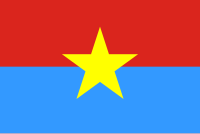 The flag of the Viet Cong, adopted in 1960, is a variation on the flag of North Vietnam.[1] Sometimes the lower stripe was green.[2][3] | |
| Also known as | Việt Cộng (VC) ⓘ |
| Leaders |
|
| Dates of operation | 1954–1959 (as southern Viet Minh cadres) December 20, 1960 – February 4, 1977 |
| Merged into | |
| Allegiance |
|
| Group(s) |
|
| Headquarters |
|
| Ideology | |
| Political position | Far-left |
| Allies | State allies:
Non-state allies: |
| Opponents | State opponents:
Non-state opponents: |
| Battles and wars | Vietnam Fatherland Front |
The Viet Cong
North Vietnam established the National Liberation Front on December 20, 1960, at Tân Lập village in
Names
The term Việt Cộng appeared in
The official Vietnamese history gives the group's name as the Liberation Army of South Vietnam or the National Liberation Front of South Vietnam (NLFSV; Mặt trận Dân tộc Giải phóng miền Nam Việt Nam).[11][nb 3] Many writers shorten this to National Liberation Front (NLF).[nb 4] In 1969, the Viet Cong created the "Provisional Revolutionary Government of the Republic of South Vietnam" (Chính Phủ Cách Mạng Lâm Thời Cộng Hòa Miền Nam Việt Nam), abbreviated PRG.[nb 5] Although the NLF was not officially abolished until 1977, the Viet Cong no longer used the name after the PRG was created. Members generally referred to the Viet Cong as "the Front" (Mặt trận).[8] Today's Vietnamese media most frequently refers to the group as the "Liberation Army of South Vietnam" (Quân Giải phóng Miền Nam Việt Nam) .[12]
History
Origin
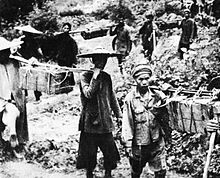
By the terms of the
About 90,000 Viet Minh were evacuated to the North while 5,000 to 10,000 cadre remained in the South, most of them with orders to refocus on political activity and agitation.[8] The Saigon-Cholon Peace Committee, the first Viet Cong front, was founded in 1954 to provide leadership for this group.[8] Other front names used by the Viet Cong in the 1950s implied that members were fighting for religious causes, for example, "Executive Committee of the Fatherland Front", which suggested affiliation with the Hòa Hảo sect, or "Vietnam-Cambodia Buddhist Association".[8] Front groups were favored by the Viet Cong to such an extent that its real leadership remained shadowy until long after the war was over, prompting the expression "the faceless Viet Cong".[8]

Led by
In March 1956, southern communist leader Lê Duẩn presented a plan to revive the insurgency entitled "The Road to the South" to the other members of the Politburo in Hanoi.[16] He argued adamantly that war with the United States was necessary to achieve unification.[17] But as China and the Soviets both opposed confrontation at this time, Lê Duẩn's plan was rejected and communists in the South were ordered to limit themselves to economic struggle.[16] Leadership divided into a "North first", or pro-Beijing, faction led by Trường Chinh, and a "South first" faction led by Lê Duẩn.
As the
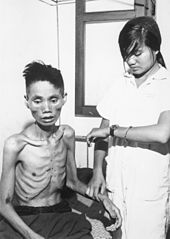
An assassination campaign, referred to as "extermination of traitors" [23] or "armed propaganda" in communist literature, began in April 1957. Tales of sensational murder and mayhem soon crowded the headlines.[8] Seventeen civilians were killed by machine gun fire at a bar in Châu Đốc in July and in September a district chief was killed with his entire family on a main highway in broad daylight.[8] In October 1957, a series of bombs exploded in Saigon and left 13 Americans wounded.[8]
In a speech given on September 2, 1957, Hồ reiterated the "North first" line of economic struggle.
Launches armed struggle
The Communist Party of Vietnam approved a "people's war" on the South at a session in January 1959 and this decision was confirmed by the Politburo in March.[15] In May 1959, Group 559 was established to maintain and upgrade the Ho Chi Minh trail, at this time a six-month mountain trek through Laos. About 500 of the "regroupees" of 1954 were sent south on the trail during its first year of operation.[27] The first arms delivery via the trail, a few dozen rifles, was completed in August 1959.[28]
Two regional command centers were merged to create the Central Office for South Vietnam (Trung ương Cục miền Nam), a unified communist party headquarters for the South.[15] COSVN was initially located in Tây Ninh Province near the Cambodian border. On July 8, the Viet Cong killed two U.S. military advisors at Biên Hòa, the first American dead of the Vietnam War.[nb 6] The "2d Liberation Battalion" ambushed two companies of South Vietnamese soldiers in September 1959, the first large unit military action of the war.[8] This was considered the beginning of the "armed struggle" in communist accounts.[8] A series of uprisings beginning in the Mekong Delta province of Bến Tre in January 1960 created "liberated zones", models of Viet Cong-style government. Propagandists celebrated their creation of battalions of "long-hair troops" (women).[29] The fiery declarations of 1959 were followed by a lull while Hanoi focused on events in Laos (1960–61).[30] Moscow favored reducing international tensions in 1960, as it was election year for the U.S. presidency.[nb 7] Despite this, 1960 was a year of unrest in South Vietnam, with pro-democracy demonstrations inspired by the South Korean student uprising that year and a failed military coup in November.[8]
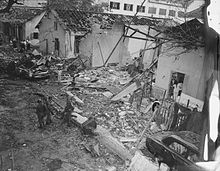
To counter the accusation that North Vietnam was violating the Geneva Accord, the independence of the Viet Cong was stressed in communist propaganda. The Viet Cong created the National Liberation Front of South Vietnam in December 1960 at Tân Lập village in Tây Ninh as a "united front", or political branch intended to encourage the participation of non-communists.[31] The group's formation was announced by Radio Hanoi and its ten-point manifesto called for, "overthrow the disguised colonial regime of the imperialists and the dictatorial administration, and to form a national and democratic coalition administration."[8] Thọ, a lawyer and the Viet Cong's "neutralist" chairman, was an isolated figure among cadres and soldiers. South Vietnam's Law 10/59, approved in May 1959, authorized the death penalty for crimes "against the security of the state" and featured prominently in Viet Cong propaganda.[32] Violence between the Viet Cong and government forces soon increased drastically from 180 clashes in January 1960 to 545 clashes in September.[33][34]
By 1960, the Sino-Soviet split was a public rivalry, making China more supportive of Hanoi's war effort.[35] For Chinese leader Mao Zedong, aid to North Vietnam was a way to enhance his "anti-imperialist" credentials for both domestic and international audiences.[36] About 40,000 communist soldiers infiltrated the South in 1961–63.[37] The Viet Cong grew rapidly; an estimated 300,000 members were enrolled in "liberation associations" (affiliated groups) by early 1962.[8] The ratio of Viet Cong to government soldiers jumped from 1:10 in 1961 to 1:5 a year later.[38]

The level of violence in the South jumped dramatically in the fall of 1961, from 50 guerrilla attacks in September to 150 in October.[39] U.S. President John F. Kennedy decided in November 1961 to substantially increase American military aid to South Vietnam.[40] The USS Core arrived in Saigon with 35 helicopters in December 1961. By mid-1962, there were 12,000 U.S. military advisors in Vietnam.[41] The "special war" and "strategic hamlets" policies allowed Saigon to push back in 1962, but in 1963 the Viet Cong regained the military initiative.[38] The Viet Cong won its first military victory against South Vietnamese forces at Ấp Bắc in January 1963.
A landmark party meeting was held in December 1963, shortly after a military coup in Saigon in which Diệm was assassinated. North Vietnamese leaders debated the issue of "quick victory" vs "protracted war" (guerrilla warfare).[42] After this meeting, the communist side geared up for a maximum military effort and the troop strength of the People's Army of Vietnam (PAVN) increased from 174,000 at the end of 1963 to 300,000 in 1964.[42] The Soviets cut aid in 1964 as an expression of annoyance with Hanoi's ties to China.[43][nb 8] Even as Hanoi embraced China's international line, it continued to follow the Soviet model of reliance on technical specialists and bureaucratic management, as opposed to mass mobilization.[43] The winter of 1964–1965 was a high-water mark for the Viet Cong, with the Saigon government on the verge of collapse.[44] Soviet aid soared following a visit to Hanoi by Soviet Premier Alexei Kosygin in February 1965.[45] Hanoi was soon receiving up-to-date surface-to-air missiles.[45] The U.S. would have 200,000 soldiers in South Vietnam by the end of the year.[46]

In January 1966, Australian troops uncovered a tunnel complex that had been used by COSVN.[47] Six thousand documents were captured, revealing the inner workings of the Viet Cong. COSVN retreated to Mimot in Cambodia. As a result of an agreement with the Cambodian government made in 1966, weapons for the Viet Cong were shipped to the Cambodian port of Sihanoukville and then trucked to Viet Cong bases near the border along the "Sihanouk Trail", which replaced the Ho Chi Minh Trail.
Many
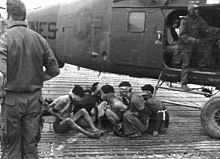
Logistics and equipment
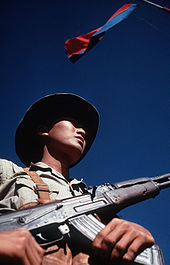
Tet Offensive
Major reversals in 1966 and 1967, as well as the growing American presence in Vietnam, inspired Hanoi to consult its allies and reassess strategy in April 1967. While Beijing urged a fight to the finish, Moscow suggested a negotiated settlement.[56] Convinced that 1968 could be the last chance for decisive victory, General Nguyễn Chí Thanh, suggested an all-out offensive against urban centers.[57][nb 9] He submitted a plan to Hanoi in May 1967.[57] After Thanh's death in July, Giáp was assigned to implement this plan, now known as the Tet Offensive. The Parrot's Beak, an area in Cambodia only 30 miles from Saigon, was prepared as a base of operations.[58] Funeral processions were used to smuggle weapons into Saigon.[58] Viet Cong entered the cities concealed among civilians returning home for Tết.[58] The U.S. and South Vietnamese expected that an announced seven-day truce would be observed during Vietnam's main holiday.
At this point, there were about 500,000 U.S. troops in Vietnam,
The offensive was undertaken in the hope of triggering a general uprising, but urban Vietnamese did not respond as the Viet Cong anticipated. About 75,000 communist soldiers were killed or wounded, according to
Aside from some districts in the
The Viet Cong created an urban front in 1968 called the Alliance of National, Democratic, and Peace Forces.[73] The group's manifesto called for an independent, non-aligned South Vietnam and stated that "national reunification cannot be achieved overnight."[73] In June 1969, the alliance merged with the Viet Cong to form a "Provisional Revolutionary Government" (PRG).
Vietnamization
The Tet Offensive increased American public discontent with participation in the Vietnam War and led the U.S. to gradually withdraw combat forces and to shift responsibility to the South Vietnamese, a process called
Fall of Saigon
In response to the
The success of the 1973–74 dry season offensive convinced Hanoi to accelerate its timetable. When there was no U.S. response to a successful communist attack on
Relationship with North Vietnam
Activists opposing American involvement in Vietnam said that the Viet Cong was a nationalist insurgency indigenous to the South.[85] They said that the Viet Cong was composed of several parties—the People's Revolutionary Party, the Democratic Party and the Radical Socialist Party[4]—and that Viet Cong chairman Nguyễn Hữu Thọ was not a communist.[86]
Anti-communists countered that the Viet Cong was merely a front for Hanoi.[85] They said some statements issued by communist leaders in the 1980s and 1990s suggested that southern communist forces were influenced by Hanoi.[85] According to the memoirs of Trần Văn Trà, the Viet Cong's top commander and PRG defense minister, he followed orders issued by the "Military Commission of the Party Central Committee" in Hanoi, which in turn implemented resolutions of the Politburo.[nb 10] Trà himself was deputy chief of staff for the PAVN before being assigned to the South.[87] The official Vietnamese history of the war states that "The Liberation Army of South Vietnam [Viet Cong] is a part of the People's Army of Vietnam".[11]
See also
- Viet Cong and PAVN strategy, organization and structure
- Viet Cong and PAVN battle tactics
- Kit Carson Scouts, former Viet Cong who worked with U.S. Marines
- People's Army of Vietnam, the North Vietnamese army
- Viet Cong and People's Army of Vietnam use of terror in the Vietnam War
Notes
- ^ Vietnamese: Việt Cộng, pronounced [vîət kə̂wŋmˀ] ⓘ; contraction of Việt Nam cộng sản (Vietnamese communist / Viet-communist)[8]
- ^ Sometimes simply National Liberation Front (NLF)
Vietnamese: Mặt trận Dân tộc Giải phóng miền Nam Việt Nam
French: Front national de libération [du Sud Viêt Nam] (FNL) - ISBN 9780853451297.). See also the "Program of the National Liberation Front of South Viet-Nam". Archived from the originalon June 26, 2010. (1967).
- ^ The terminology "liberation front" is adapted from the earlier Greek and Algerian National Liberation Fronts.
- ^ This also follows terminology used earlier by leftists in Greece (Provisional Democratic Government) and Algeria (Provisional Government of the Algerian Republic).
- Charles Ovnand, the first names to appear on the Vietnam Veterans Memorial.
- ISBN 0-262-62066-9.)
- ^ There was also a U.S. presidential election in 1964.
- ^ Disappointed with the results of the 1964 U.S. presidential election, the Kremlin did not try to influence the election of 1968. Desiring "businesslike" relations, the Kremlin favored incumbent Richard Nixon against left-wing challenger George McGovern in 1972. (Lynn-Jones, p. 29).
- ^ Trà begins, "How did the B2 theater carry out the mission assigned it by the Military Commission of the Party Central Committee?" (Trần Văn Trà (1982), Vietnam: History of the Bulwark B2 Theatre, archived from the original on June 2, 2011)
References
- ^ "National Liberation Front (Viet Cong)". www.fotw.info. Archived from the original on April 18, 2023.
- ISBN 9781476639925– via Google Books.
- ISBN 9781545749463– via Google Books.
- ^ a b Burchett, Wilfred (1963): "Liberation Front: Formation of the NLF", The Furtive War, International Publishers, New York. (Archive)
- ^ Possibly a pseudonym for Trần Văn Trà. "Man in the News: Lt.-Gen. Tran Van Tra". February 2, 1973. Archived from the original on August 23, 2009.
- ^ Bolt, Dr. Ernest. "Provisional Revolutionary Government of South Vietnam (1969–1975)". University of Richmond. Archived from the original on October 26, 2014. Retrieved June 28, 2008.
- JSTOR 24912244. Retrieved July 29, 2021.
- ^ a b c d e f g h i j k l m n o p q "Origins of the Insurgency in South Vietnam, 1954–1960". The Pentagon Papers. 1971. pp. 242–314. Archived from the original on October 19, 2017. Retrieved June 13, 2008.
- ^ Nguyen, Thanh Huu (December 18, 2015). "National Liberation Front for South Vietnam in resistance war against the U.S., for national salvation". National Defence Journal. Ministry of Defence (Vietnam). Retrieved December 22, 2023.
- ^ "Viet Cong", Oxford English Dictionary
- ^ ISBN 0-7006-1175-4.
- ^ See, for example, this story in Viet Nam News, the official English-language newspaper.
- ^ Karnow, p. 238.
- ^ a b Karnow, p. 245.
- ^ a b c "The History Place — Vietnam War 1945–1960". Archived from the original on March 12, 2023. Retrieved June 11, 2008.
- ^ ISBN 0-7007-1615-7.
- ^ a b Ang, p. 21
- ^ Olson, James; Randy Roberts (1991). "Where the Domino Fell: America and Vietnam, 1945–1990". New York: St. Martin's Press: 67.
{{cite journal}}: Cite journal requires|journal=(help) This decision was made at the 11th Plenary Session of the Lao Động Central Committee. - ^ Ang, p. 19
- ^ Võ Nguyên Giáp. The Political and Military Line of Our Party. pp. 179–80.
{{cite book}}:|work=ignored (help) - ^ Ang, p. 20.
- ^ U.S. Information Agency. (August 24, 1982 – January 10, 1999) (1966). The effects of just one month spent in a Viet Cong prison camp show on 23-year-old Le Van Than, who had defected from the Communist forces and joined the Government side, was recaptured by the Viet Cong and deliberately starved. Series: Master File Photographs of U.S. And Foreign Personalities, World Events, and American Economic, Social, and Cultural Life, 1900 – 2003. Archived from the original on May 4, 2023. Retrieved August 14, 2020.
{{cite book}}:|website=ignored (help)CS1 maint: multiple names: authors list (link) CS1 maint: numeric names: authors list (link) - )
- ^ Ang, p. 23.
- ^ a b Ang, pp. 24-25.
- ^ Karnow, p. 693.
- ^ Victory in Vietnam, p. xi.
- ISBN 1-84603-020-X.
- ISBN 0-8021-3362-2.
- ^ Ang, p. 7.
- ^ Ang, p. 58.
- ^ Gettleman, p. 156.
- ^ Kelly, Francis John (1989) [1973]. History of Special Forces in Vietnam, 1961–1971. Washington, D.C.: United States Army Center of Military History. p. 4. CMH Pub 90-23. Archived from the original on February 12, 2014. Retrieved August 5, 2010.
- ^ Nghia M. Vo Saigon: A History 2011 – Page 140 "... on December 19 to 20, 1960, Nguyễn Hữu Thọ, a Saigon lawyer, Trương Như Tảng, chief comptroller of a bank, Drs. Dương Quỳnh Hoa and Phùng Văn Cung, along with other dissidents, met with communists to form the National Liberation Front..."
- ISBN 0-8078-4842-5.
- ^ Zhai, p. 5.
- ^ Ang, p. 76.
- ^ a b Victory in Vietnam, p. xii.
- ^ Ang, p. 113.
- ^ Pribbenow, Merle (August 1999). "North Vietnam's Master Plan". Vietnam. Archived from the original on April 9, 2023.
- ^ Karnow, p.694
- ^ a b Ang, p. 74-75.
- ^ a b Zhai, p. 128.
- ^ Victory in Vietnam, p. xiii.
- ^ a b Karnow, p. 427.
- ^ a b "1957–1975: The Vietnam War". libcom. Archived from the original on May 17, 2022.
- ^ "VC Tunnels". Digger History.
- ISBN 978-0-517-07201-1. The Viet Cong were commonly referred to by the Vietnamese rural population as "night bandits" or the "night government".
- ^ Zumbro, pp. 25, 33
- ^ Zumbro, p. 32.
- ^ a b U.S. Senate Judiciary Committee, The Human Cost of Communism in Vietnam" (1972), p. 8-49.
- ^ "The My Canh Restaurant bombing". Archived from the original on November 25, 2010. Retrieved July 30, 2008.
- ^ Krohn, Charles, A., The Last Battalion: Controversies and Casualties of the Battle of Hue. pg. 30. Westport 1993.
Jones, C. Don, Massacre at Dak Son Archived November 29, 2014, at the Wayback Machine, United States Information Service, 1967
"On the Other Side: Terror as Policy". Time. December 5, 1969. Archived from the original on May 22, 2013. Retrieved July 17, 2008.
"The Massacre of Dak Son". Time. December 15, 1967. Archived from the original on July 21, 2013. Retrieved June 15, 2008. Pictures of Dak Son can be viewed here Archived February 19, 2020, at the Wayback Machine. - ^ Guenter Lewy, America in Vietnam, (Oxford University Press, 1978), pp272-3, 448–9.
- ^ Pedahzur, Ami (2006), Root Causes of Suicide Terrorism: The Globalization of Martyrdom, Taylor & Francis, p.116.
- ^ Ang, p. 115.
- ^ a b Ang, pp. 116–117.
- ^ ISBN 0-8021-3362-2.
- ^ Westmoreland, p. 344 (editor's note).
- ISBN 9780939526062.
- ^ "The Massacre of Hue". Time. October 31, 1969. Archived from the original on December 4, 2007.
Pike, Douglas. "Viet Cong Strategy of Terror". pp. 23–39. Archived from the original on December 6, 2022. - ^ Kearny, Cresson H. (Maj) (1997). "Jungle Snafus...and Remedies". Oregon Institute of Science and Medicine: 327.
{{cite journal}}: Cite journal requires|journal=(help) - ^ Lee, Nathan (April 10, 2009). "A Dark Glimpse From Eddie Adams's Camera". The New York Times. Archived from the original on June 15, 2018.
- ^ Walter Cronkite on the Tet Offensive, archived from the original on July 19, 2008
- ^ Tran Van Tra. "Tet".
{{cite journal}}: Cite journal requires|journal=(help) in Warner, Jayne S. Warner (1993). Luu Doan Huynh (ed.). The Vietnam War: Vietnamese and American Perspectives. Armonk, NY: M.E. Sharpe. pp. 49–50.. - ^ Tran Van Tra. "Comments on Tet '68". Archived from the original on August 7, 2011.
- ^ a b "Vietnam Veterans for Academic Reform". Archived from the original on February 26, 2009.
- ^ Crowell, Todd Crowell (October 29, 2006). "The Tet Offensive and Iraq". Archived from the original on August 23, 2009.
- ISBN 1-85109-899-2.
- ^ "Failure of the Viet Cong to establish liberation committees". Declassified CIA Documents on the Vietnam War. February 22, 1991. Archived from the original on March 7, 2021.
- ^ a b Whitcomb, Col Darrel (Summer 2003). "Victory in Vietnam: The Official History of the People's Army of Vietnam, 1954–1975 (book review)". Air & Space Power Journal. Archived from the original on February 7, 2009.
- ^ ISBN 978-0-8014-2168-6.
- ^ a b Porter, pp. 27–29
- ^ Ang, p. 138.
- ^ Ang, p. 139.
- ^ Ang, p. 53.
- ^ a b Ang, p. 52.
- ^ "The Vietcong". www.vietnampix.com. Archived from the original on October 5, 2022.
- ^ Karnow, p. 673.
- ^ Tran Van Tra. "Vietnam: History of the Bulwark B2 Theatre". Archived from the original on May 28, 2009.
- ^ Karnow, pp 644–645.
- ^ Karnow. pp. 672–74.
- ^ a b Porter, p. 29
- ^ Porter, p. 28.
- ^ ISBN 1-85728-323-6
- ISBN 0-670-84218-4., p. 255.
- ^ Bolt, Dr. Ernest. "Who is Tran Van Tra?". Archived from the original on July 10, 2011. Retrieved April 7, 2009.
Further reading
- U.S. Senate Judiciary Committee, The Human Cost of Communism in Vietnam (1972) .
- Marvin Gettleman, et al. Vietnam and America: A Documented History. Grove Press. 1995. ISBN 0-8021-3362-2. See especially Part VII: The Decisive Year.
- Truong Nhu Tang. A Vietcong Memoir. Random House. ISBN 0-394-74309-1. 1985. See Chapter 7 on the forming of the Viet Cong, and Chapter 21 on the communist take-over in 1975.
- Frances Fitzgerald. ISBN 0-316-28423-8. See Chapter 4. "The National Liberation Front".
- Douglas Valentine. The Phoenix Program. New York: William Morrow and Company. 1990. ISBN 0-688-09130-X.
- Merle Pribbenow (translation). Victory in Vietnam: The Official History of the People's Army of Vietnam. University Press of Kansas. 2002 ISBN 0-7006-1175-4
- Morris, Virginia and Hills, Clive. 2018. Ho Chi Minh's Blueprint for Revolution: In the Words of Vietnamese Strategists and Operatives, McFarland & Co Inc.
External links
- Tet Offensive 1968, US Embassy & Saigon fighting. CBS News footage of the Tet Offensive.
- Vietnam War – Hue Massacre 1968. A tribute to the dead of Huế by Trịnh Công Sơn, one of wartime Vietnam's most prominent composers.
- The Wars for Vietnam: 1945–1975. Primary documents concerning the Vietnam War, including peace proposals, treaties, and platforms.
- Digger History, VC Tunnels. At one point, Viet Cong tunnels stretched from the Cambodia border to Saigon.
- The Viet Cong 1965–1967 – part 1 and The Viet Cong 1965–1967 – part 2. What was it like to be a Viet Cong? This recruiting video shows one perspective.
- "Tiên vê Sài Gòn" (Forward to Saigon.) This propaganda video features singing Viet Cong and newsreel footage from the 1975 offensive.
